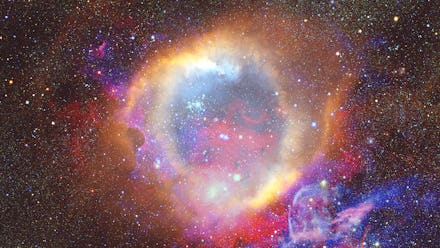Scientists just figured out how giant magnets are formed in space

The science behind magnets is fascinating, especially when speaking about some of the most powerful magnetic forces in our universe: magnetars. No, that's not some sort of special new Pokémon or a mythological creature. A magnetar is a type of neutron star with overwhelmingly powerful magnetic fields. Scientists haven't ever been very clear on exactly how they form in the first place, but thanks to a new study published Wednesday in Nature and rigorous computer simulations, things are starting to make a bit more sense.
Heidelberg University astronomer Fabian Schneider led a team that created models using advanced supercomputers to demonstrate how the mergers of these stars can explain the magnetic fields observed in "a subset of massive stars." This also included the potential origin of magnetars. According to the simulations, magnetars could very well be formed as the result of two stars hurtling toward each other until they violently and explosively merge together.
"At the end of the life of the merged star, a supernova explosion will likely produce a magnetar,” Schneider told Vice in an email. "Our paper is about the merging of stars and the formation of strong magnetic fields."
Schneider and his team utilized a simulation called the AREPO Code to try and model their hypothesis, in which the aforementioned "stellar mergers" form magnetars. They chose a star about 500 light-years from Earth called Tau Scorpii to run the simulation on, as projections find it potentially becoming a magnetar in the future. In fact, it's likely already the product of a merger between stars already. The team refers to Tau Scorpii as a "blue straggler" star.
After stars come together, a newly-merged star may remain stable for some time, but its explosion into a massive supernova eventually turns it into a magnetar. The explosion happens, according to Astronomical Observatory of Trieste research fellow Paul Sutter, after a star's "fuel" in its core runs out, "allowing gravity to temporarily win and crush the star's core even tighter."
After the explosion, the star has turned into a neutron star, which carries an already powerful magnetic field - a "trillion-gauss magnetic field." Named for mathematician Carl Friedrich Gauss, "Gauss" refers to the intensity of a magnetic field in a given area. For perspective, a refrigerator magnet is about 100 gauss at its strongest.
Comparatively (perhaps shockingly), magnetars are magnetic up to 1 quadrillion gauss. As Sutter points out, that's "1,000 trillion times stronger than the magnetic field you're sitting in right now." Magnetars sound pretty terrifying with that in mind, honestly.
If Tau Scorpii does erupt in a supernova later down the line like the models suggest, it could show the same behavior as the team hypothesized. The explosion may even emit FRBs, or fast radio bursts, which are pulses of radio light that scientists have yet to find an explanation for. They're believed to be emitted during the formation fo a magnetar and could be produced by the magnetar's shifting magnetic fields, according to Schneider and his team.
There is a lot more research and work to be completed to determine the exact case here, but when all was said and done, Schneider's team determined that "massive blue stragglers" like Tau Scorpii could be the progenitors of magnetars.
"We have run the very first three-dimensional simulation of two massive stars merging that can follow the magnetic field amplification process,” said Schneider. “This enables us to study stellar mergers now in a broader context — in the end, we think that about 25% of all massive stars will merge with a companion! A whole new world to explore."
A whole new universe to explore might be more like it – we're always trying to figure out how to explain the various phenomena in the skies that surround us. Perhaps this is another important first step in understanding.